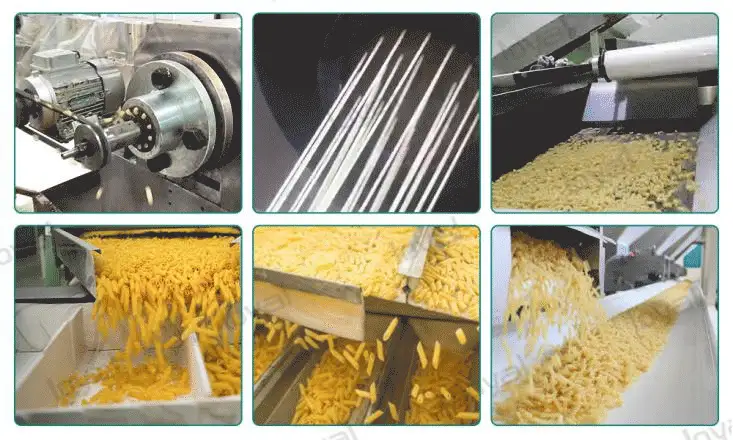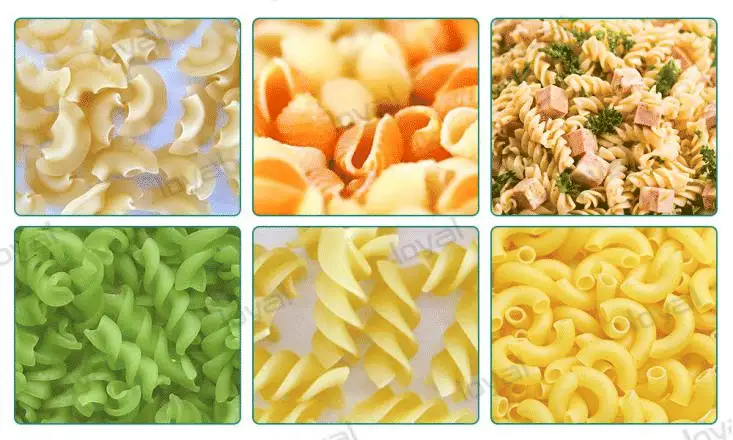Breaking Down the Costs: What's the Price of Homemade Spaghetti?
Spaghetti, a staple in many households around the world, is cherished for its simplicity, versatility, and the comfort it brings to the dinner table. From a quick weeknight dinner to a lavish meal with a variety of sauces and toppings, spaghetti dishes can suit any occasion and palate. This universal appeal has cemented its status as one of the most beloved home-cooked meals. However, despite its apparent simplicity, the costs associated with making spaghetti at home can vary widely, influenced by choices in ingredients, equipment, and cooking methods.
The purpose of this article is to delve into the financial aspect of preparing homemade spaghetti. We aim to provide a detailed breakdown of the costs involved, from the basic ingredients to the optional use of a macaroni manufacturing machine for those who venture into making pasta from scratch. By examining these costs, we aspire to offer insights that will help readers make informed decisions about their cooking practices, balancing the scales of economy and gourmet delight in their kitchen endeavors.


Key Ingredients and Their Costs
The journey to a delicious plate of homemade spaghetti begins with gathering the essential ingredients: pasta, tomato sauce, olive oil, and, depending on personal preference, optional ingredients like meat or vegetables. The cost of these ingredients can vary significantly, influenced by factors such as brand choice, quality, and where you shop.
Pasta
The cornerstone of any spaghetti dish is the pasta itself. Prices can range from budget-friendly generic brands to more expensive artisanal or specialty pasta. For those considering the use of a macaroni manufacturing machine, the cost of raw ingredients (flour and eggs, if making egg pasta) must also be considered. While the initial investment in raw materials might be higher, homemade pasta offers a fresher taste and a customizable cooking experience.
Tomato Sauce
Tomato sauce prices vary widely based on brand, quality, and ingredients. Pre-made sauces offer convenience but at a higher cost, especially for premium or organic options. Alternatively, making sauce from scratch with canned or fresh tomatoes can be more cost-effective and customizable.
Olive Oil
A staple in Mediterranean cooking, the price of olive oil ranges from relatively inexpensive to premium prices for extra virgin or imported varieties. The choice of olive oil can influence the flavor profile of the dish, with higher quality oils providing a more robust taste.
Optional Ingredients
Meat, such as ground beef or Italian sausage, and vegetables, like onions, garlic, and bell peppers, add depth and nutrition to the dish but also contribute to the overall cost. The price of these additions will vary depending on the type of meat, the quality of the vegetables, and seasonal availability.
When considering generic versus brand-name products, culinary expert Chef Anna Rossi suggests, "Opting for generic brands for basic ingredients like pasta and olive oil can significantly reduce costs without compromising the quality of your dish. However, when it comes to tomato sauce and optional ingredients like meat and vegetables, investing in higher quality products can elevate the flavor of your spaghetti."
By carefully selecting ingredients and considering the balance between cost and quality, home cooks can manage their budget while still creating a delicious and satisfying meal. Whether using store-bought pasta for convenience or embracing the art of pasta making with a macaroni manufacturing machine, understanding the costs involved is the first step towards mastering the art of homemade spaghetti.
Equipment and Utensils
Preparing homemade spaghetti requires more than just the right ingredients; the proper kitchen equipment and utensils play a pivotal role in the cooking process. While most kitchens are equipped with the basics needed for pasta making, such as pots, strainers, and stirring utensils, making pasta from scratch introduces the need for specialized equipment, notably the macaroni manufacturing machine.
Basic Kitchen Equipment
The essentials for cooking spaghetti include a large pot for boiling the pasta, a strainer or colander for draining, a skillet or saucepan for preparing the sauce, and various utensils like spoons and tongs for stirring and serving. These items are generally standard in most kitchens and do not represent a significant additional cost.
The Role of a Macaroni Manufacturing Machine
For those who prefer homemade pasta, a macaroni manufacturing machine becomes an invaluable tool. These machines range from simple hand-crank models to more sophisticated electric pasta makers. The cost of a macaroni manufacturing machine varies widely, with manual models being more affordable and electric models representing a higher initial investment.
Despite the upfront cost, the benefits of owning a pasta maker are manifold. Homemade pasta not only offers a fresher taste and a more authentic cooking experience but also allows for customization in terms of shape, thickness, and ingredients. Culinary blogger and pasta enthusiast, Marco Bianchi, notes, "Investing in a good quality macaroni manufacturing machine can transform your pasta dishes, giving them a superior texture and flavor that store-bought pasta simply can't match."
Cost Analysis: One-Time Investment vs. Long-Term Usage
While the purchase of a pasta machine may seem like a significant one-time expense, its value extends over many uses. The longevity of a good-quality macaroni manufacturing machine can make it a cost-effective investment over time, especially for those who frequently make pasta at home. The cost per use decreases with each batch of pasta made, offsetting the initial investment and potentially saving money compared to buying premium or artisanal pasta from the store.
In conclusion, while basic kitchen equipment is sufficient for preparing spaghetti with store-bought pasta, investing in a macaroni manufacturing machine elevates the homemade pasta experience. Though it represents a one-time investment, the long-term benefits—ranging from enhanced flavor and texture to the joy of culinary creation—make it a worthy addition to the home cook's arsenal.
Homemade Pasta: Pros and Cons
The decision to make pasta at home versus buying pre-made pasta is one many cooks face, especially when considering the investment in a macaroni manufacturing machine. This choice involves weighing the benefits of homemade pasta against the convenience of store-bought options, alongside the cost and time investment each requires.
Pros of Using a Macaroni Manufacturing Machine
- Customization: Homemade pasta offers unparalleled control over ingredients, allowing for adjustments in flavor, texture, and nutritional content. Whether incorporating whole grains for added health benefits or infusing the dough with herbs and vegetables for color and taste, a macaroni manufacturing machine offers a canvas for creativity.
- Freshness and Taste: Freshly made pasta boasts a superior taste and texture compared to most store-bought varieties. The freshness enhances the overall dining experience, elevating simple dishes to gourmet standards.
- Cost Savings in the Long Run: For avid pasta enthusiasts, the initial cost of a pasta machine can be offset over time by the savings garnered from making pasta at home, especially when considering the price of high-quality artisanal pasta varieties.
Cons of Homemade Pasta
- Time Investment: Making pasta from scratch is a time-consuming process, requiring the preparation of dough, resting periods, and the actual pasta-making and cutting. For busy individuals or families, this time commitment may not always be feasible.
- Learning Curve: Mastering the art of pasta making, including the optimal dough consistency and the use of a macaroni manufacturing machine, can take time and practice. Initial attempts may not always yield the desired results.
- Storage and Shelf Life: Unlike dried pasta, fresh homemade pasta must be consumed relatively quickly or properly stored in the refrigerator or freezer, which may be inconvenient for some.
Culinary expert, Chef Roberto Flores, remarks on the decision to make pasta at home: "The choice to use a macaroni manufacturing machine for homemade pasta is a testament to one's dedication to the craft of cooking. While it demands more time and effort, the payoff in terms of taste and satisfaction is immense. It reconnects us with the traditional art of pasta making, offering a sense of accomplishment and a deeper appreciation for our meals."
In analyzing the cost, time investment, and taste differences between homemade and store-bought pasta, it becomes clear that the decision largely hinges on personal preferences and lifestyle. For those who value the authenticity and customization of homemade pasta and are willing to invest in a macaroni manufacturing machine, the rewards extend beyond the plate, offering a fulfilling culinary experience.
Tips for Cost-Effective Spaghetti Making
Creating delicious spaghetti dishes at home doesn’t have to strain your budget. With strategic choices and a bit of planning, it’s possible to enjoy homemade spaghetti that’s both affordable and satisfying. Here are some strategies to make spaghetti making more cost-effective, especially if you're considering the use of a macaroni manufacturing machine for fresh pasta.
Bulk Buying
Purchasing ingredients in bulk can lead to significant savings, especially for staples like flour and olive oil, which have a long shelf life. For those making pasta from scratch with a macaroni manufacturing machine, buying flour and eggs in bulk can reduce the cost per serving of homemade pasta.
Choosing Seasonal Vegetables
Incorporating vegetables into your spaghetti sauce not only boosts its nutritional value but can also be cost-effective when you opt for seasonal produce. Seasonal vegetables are often cheaper and fresher, enhancing the flavor of your dish without adding much to the cost.
Making Sauce in Large Batches
Tomato sauce can be made in large quantities and preserved by freezing or canning. This approach not only saves time but also money, as buying ingredients for sauce in bulk can be cheaper than purchasing pre-made sauces. Homemade sauce also allows for customization according to taste preferences and dietary needs.
Utilizing Leftovers
Incorporating leftovers into your spaghetti dishes is a smart way to minimize waste and reduce costs. Almost any leftover meat or vegetables can be added to spaghetti sauce, giving it a new flavor profile and making your meal more substantial.
Maximizing the Use of Your Macaroni Manufacturing Machine
For those who have invested in a macaroni manufacturing machine, making the most of this equipment involves more than just making spaghetti. These machines often come with attachments for different pasta shapes, allowing for a variety of pasta dishes from a single batch of dough. Experimenting with different pasta types can keep meals interesting and make the most of your investment.
Culinary blogger, Emily Johnson, emphasizes the value of a pasta machine: "A macaroni manufacturing machine isn’t just for spaghetti. It’s a gateway to exploring the vast world of homemade pasta. From fettuccine to ravioli, the possibilities are endless, and making different types of pasta can be a cost-effective way to diversify your meals."
Adopting these strategies can make spaghetti making a more affordable and enjoyable endeavor. Whether you’re using store-bought pasta for convenience or delving into the world of homemade pasta with a macaroni manufacturing machine, these tips can help enhance your culinary experience while keeping an eye on the budget.
Conclusion
Exploring the costs involved in making homemade spaghetti, from ingredient selection to the potential investment in a macaroni manufacturing machine, reveals a landscape rich with options for customization, quality control, and cost efficiency. The journey from a simple plate of spaghetti to a gourmet meal tailored to personal tastes and dietary preferences encapsulates the joy and challenge of home cooking.
The analysis provided demonstrates that while making spaghetti at home can vary in cost, the flexibility it offers allows individuals to adapt their cooking practices to fit their budgetary and culinary needs. Whether opting for the convenience of store-bought pasta or embracing the art of pasta making with a macaroni manufacturing machine, cooks have the power to influence the cost, quality, and nutritional value of their meals.
In conclusion, the art of making spaghetti at home is as much about the process as it is about the outcome. It presents an opportunity to engage with food in a meaningful way, exploring the nuances of flavor, texture, and nutrition. The investment in equipment like a macaroni manufacturing machine might seem daunting at first, but for those passionate about pasta, it offers a gateway to unlimited culinary creativity and a deeper appreciation for the craft of cooking.
Ultimately, the decision on how to make spaghetti at home boils down to personal preferences, lifestyle, and budget. By employing strategies for cost-effective spaghetti making and maximizing the use of available resources, individuals can enjoy high-quality, delicious spaghetti meals that reflect their dedication to good food and smart budgeting. The price of homemade spaghetti, therefore, transcends monetary value, enriching our lives with flavors that resonate with our individual stories and culinary journeys.













